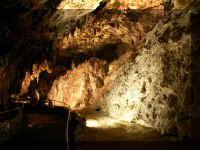 The
walkway around in the Big Room has a non-slip surface and stainless steel railings. The walk was
generally easy with no steps - all inclines. Wheelchairs can be used on most of
the path if they have an attendant.
The
walkway around in the Big Room has a non-slip surface and stainless steel railings. The walk was
generally easy with no steps - all inclines. Wheelchairs can be used on most of
the path if they have an attendant.New Mexico - 2006
Updated: 11/30/08
Carlsbad Caverns National Park
Carlsbad Caverns National Park
We took the elevator down 750 feet to the Big Room from the Visitor Center. There is also the traditional explorer's route into the entrance to the Big Room requiring a walk on a steep path. We were told it was a beautiful walk but a challenge to many people.

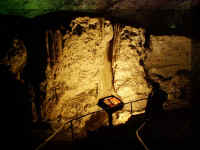
The temperature in the cavern is a comfortable 56 degrees - a long sleeve shirt or light jacket should be carried so it is available if needed.
There are two routes in the Big Room. One is a little shorter so, of course, it misses a few features. The information sheet says the one mile stroll around the perimeter of the Big Room will take about 1.5 hours. You could probably walk it in that amounts of time. However, if you stop for many photographs or talk to the rangers, it will take longer. It took us almost four hours. Allowing two hours seems like a reasonable length of time. Some visitors brought their own flashlights to examine the features more closely.
It is dark in the Big Room with the features lit with lamps placed by a professional theatrical lighting specialist. Generally, we did not use flash photography so as not to affect the professionally designed lighting. [Note: The next visit to a cavern, Fred will take his uni-pod to steady the camera.]
The features along the way were spectacular. To do them justice, a 3-D camera would be needed. The depth and height of the features and the size of the stalactites and the stalagmites are not evident in photographs - nothing gives you a size comparison. What follows is a few of the photographs we made.
Because Fred saw more green in the camera image than our naked eye saw, he asked one of the rangers making rounds of the Big Room if colored lamps were used. She said 'no' but, that the wave length of some of the lamps can cause algae to grow.
Most of the time the green tinge did not appear.
This formation is growing as are many others in the cavern. Fred used flash to show some of its detail.
We saw this Roadrunner in the parking lot.
Admission to the park, including the elevator ride, was $7 for adults. There are not many pull-offs on the road to the caverns - none for a large RV. There should be room in the parking lot for your RV. However, if possible, leave your RV in camp and drive your tow/towed vehicle the sixteen miles to the caverns.
If you have an interest in cave exploration this is a good destination. Besides the two self-guided tours, there are six ranger-guided tours of various levels of adventure. For some, you must supply your own gloves, knee-pads and 4 "AA" batteries! Of course, there is an additional charge for these adventure tours.
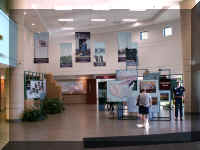
You are actually visiting an office building that has displays in the lobby and presents a short video.
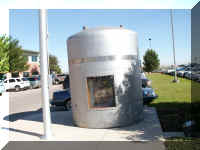
The actual storage location is about 45 miles from the office and twelve miles off the highway. Visitors are not permitted there. In the following photographs which are made from pictures in the display, a trucks carrying containers and the actual underground storage location can be seen.
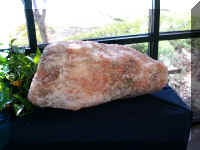
The material processed and isolated at WIPP is contact-handled transuranic (TRU) waste. TRU waste consist primarily of protective clothing, tools, glassware, equipment, soils, and sludges that have been contaminated with trace amounts of manmade radioactive elements, such as plutonium. These elements have a atomic number greater than uranium - thus transuranic (beyond uranium).
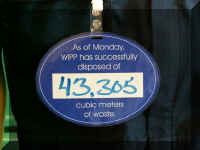
There is no admission fee to visit the WIPP building. Be aware that RV parking is non-existent. We were there in the off-season and parked along the curb in an aisle of their parking lot for our brief half-hour visit.
This WIPP facility is the first deep geologic repository for permanent disposal of defense-related transuranic waste in the United States. At full operation, a dedicated fleet of trucks with custom trailers will transport waste to the WIPP from 20 sites across the nation. This map shows temporary storage locations in addition to the WIPP location.
Albuquerque has decorated their overpasses and sound barrier walls to make them more appealing. The medians are also landscaped with plants and in a couple locations huge colorful ceramic pots are included in the design. They also use a lot of colored concrete/adobe.
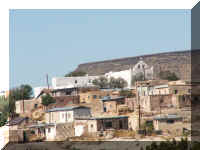
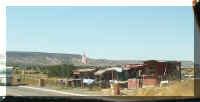
Views on the road . . .
After driving through miles and miles of desert conditions, we came across an area with standing water on both sides of the road. The person in the visitor center down the road told us it was water from their last rainfall two months earlier. It just did not soak into the dry lake bed.